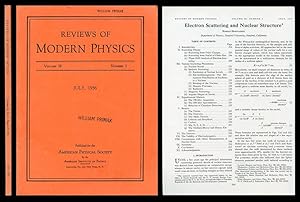About this Item
ROBERT HOFSTADTER'S SEMINAL, NOBEL PRIZE WINNING PAPER SUMMARIZING HIS WORK ON ELECTRON SCATTERING AND ATOMIC STRUCTURE. Hofstadter was able to show results that were "achieved with a precision that had scarcely been attained before in high-energy physics, [and that showed] persuasively that the proton and the neutron are extended structures; "nuclei were thereby proven not to be homogeneous, but to have internal structures) (Nobel Prize Committee). Robert Hofstadter (1915 - 1990) was an American physicist who won the 1961 Nobel Prize in Physics, with Rudolf Mössbauer, "for [their] pioneering studies of electron scattering in atomic nuclei and for his consequent discoveries concerning the structure of nucleons" (ibid). In order to conduct the first ever high-energy electron scattering experiments, Hofstadter worked with the Stanford linear accelerator, adding apparatus he had developed for studying the internal structure of nuclei. It was understood at that time that matter is composed of atoms with small nuclei surrounded by electrons. The high-energy beam of the accelerator was directed toward nuclei "and by examine the scattering of the electrons, [Hofstadter] could investigate how charges were distributed. [Hofstadter] could also investigate how the magnetic moment within the nuclei's protons and neutrons was distributed" (Nobel Prize Portal). Hofstadter's experiments continued for years, reviewing his data in 1956 and presenting it in this paper. "The results showed that what long been assumed, namely, that the proton and neutron are different aspects of the same particle; and, moreover, that this particle, the nucleon, is an object of finite size, although not sharply delimited" (Kragh, Quantum Generations, 282-283). "Contrary to heavy nuclei, which have a well-defined radius, the charge density of nucleons was found to decrease smoothly from the center. Hofstadter pictured the nucleons as being surrounded by clouds of mesons, with the clouds adding together in the proton and cancelling in the neutron. His experiments showed, as he said, at the end of his 1961 Nobel lecture, that "the proton and neutron, which were once thought to be elementary particles, are now seen to be highly complex bodies" (Kragh). CONDITION & DETAILS: Lancaster: American Physical Society. Complete issue in original wraps. 4to. (10.5 x 8 inches; 263 x 200mm). This is not an ex-libris copy; ownership stamp of the physicist William Primak on the front wrap. Very slight wear at the edges of the wraps. and head of the spine. Near fine condition inside and out. Seller Inventory # 797
Contact seller
Report this item
![]()
